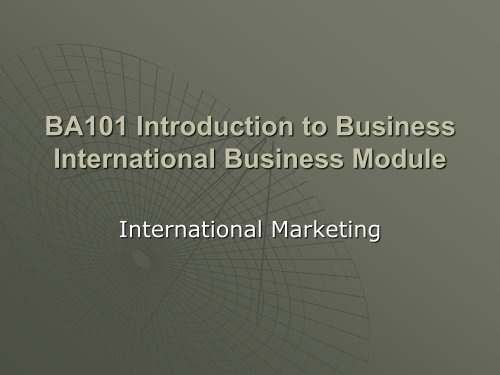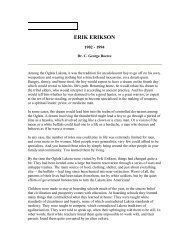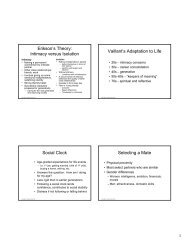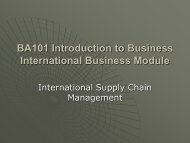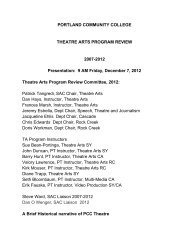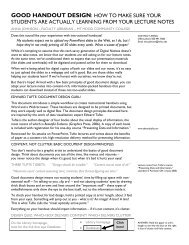BA101 Introduction to Business International Business Module
BA101 Introduction to Business International Business Module
BA101 Introduction to Business International Business Module
Create successful ePaper yourself
Turn your PDF publications into a flip-book with our unique Google optimized e-Paper software.
<strong>BA101</strong> <strong>Introduction</strong> <strong>to</strong> <strong>Business</strong><br />
<strong>International</strong> <strong>Business</strong> <strong>Module</strong><br />
<strong>International</strong> Marketing
Learning Objectives<br />
� Review <strong>International</strong> Marketing<br />
Blunders<br />
� Understand Key Marketing Concepts<br />
� Review Product Considerations<br />
� Understand the importance of<br />
building cus<strong>to</strong>mer relationships<br />
internationally
<strong>International</strong> Marketing Blunders<br />
� The company Electrolux, a Scandinavian company that<br />
manufactures and sells vacuum cleaners, first attempted <strong>to</strong><br />
market in the United States in the 1970s. Their chosen slogan<br />
was, "Nothing sucks like an Electrolux."<br />
� When American car company GM tried <strong>to</strong> market its popular<br />
Chevy Nova in Latin America, sales were extremely disappointing.<br />
They only later realized that the term "Nova" means "doesn't go."<br />
� The American baby food company Gerber, usually sells its jars of<br />
baby food with a picture of the Gerber Baby on the label. In<br />
certain areas of the Middle East, it is cus<strong>to</strong>mary <strong>to</strong> put pictures of<br />
the contents on the label, largely due <strong>to</strong> high illiteracy rates<br />
among women. When Gerber put the Baby on the label, people<br />
thought that it was actually made from babies.<br />
� A German consumer goods company that tried <strong>to</strong> market and sell<br />
<strong>to</strong>ilet paper and other paper goods in the United States named<br />
their goods, "Krapp."<br />
� When Pepsi tried <strong>to</strong> use its slogan, "Come Alive with Pepsi" in<br />
China, the translation came <strong>to</strong> mean, "Bring back your dead<br />
ances<strong>to</strong>rs with Pepsi.”<br />
Source: http://everything2.com/title/Marketing%2520blunders
<strong>International</strong> Marketing Blunders Cont..<br />
� The Swedish furniture giant IKEA somehow agreed upon the name<br />
"FARTFULL" for one of its new desks. Enough said..<br />
� When Braniff <strong>International</strong> Airways translated a slogan <strong>to</strong>uting its<br />
upholstery, “Fly in leather”, it came out in Spanish as “Fly naked”.<br />
� There are several examples of companies getting tangled up with bad<br />
translations of products due <strong>to</strong> the word "mist". We had "Irish Mist" (an<br />
alcoholic drink), "Mist Stick" (a curling iron from Clairol) both flopping as<br />
"mist" in German means dung/manure. Fancy a glass of Irish dung?<br />
� In 2002, Umbro the UK sports manufacturer had <strong>to</strong> withdraw its new<br />
trainers (sneakers) called the Zyklon. The firm received complaints from<br />
many organisations and individuals as it was the name of the gas used by<br />
the Nazi regime <strong>to</strong> murder millions of Jews in concentration camps.<br />
� Sharwoods, a UK food manufacturer, spent £6 million on a campaign <strong>to</strong><br />
launch its new 'Bundh' sauces. It received calls from numerous Punjabi<br />
speakers telling them that "bundh" sounded just like the Punjabi word for<br />
"arse".<br />
As can be seen with these few examples, international business<br />
and especially international marketing has opened the door <strong>to</strong> a<br />
few laughs. With the increasing amount of globalization occurring<br />
<strong>to</strong>day, it will be interesting <strong>to</strong> see what blunders may come.
Overview of Key Concepts - I<br />
Organization Level Type of Strategic Plan Key Strategic Decisions<br />
Corporate level Corporate strategic plan Corporate vision<br />
Corporate objectives and resource<br />
allocation<br />
Corporate growth strategies<br />
<strong>Business</strong>-unit composition<br />
<strong>Business</strong> unit level <strong>Business</strong> strategic plan Market scope<br />
Competitive advantage<br />
Functional level Marketing strategic plan Target market approach<br />
(Marketing)<br />
Marketing mix approach<br />
Source: Marketing Principles and Perspectives, Bearden et al. (2004)
Key Concept II<br />
� <strong>International</strong> <strong>Business</strong> focuses on teaching<br />
about business functions. <strong>International</strong><br />
Marketing focuses on teaching marketing<br />
functions.<br />
• Focus on Target Market<br />
• Focus on Marketing Mix
Product Consideration<br />
� How attractive is the product or service <strong>to</strong><br />
international markets?<br />
• Can the product be adapted <strong>to</strong> a foreign<br />
market?<br />
• How close are you <strong>to</strong> those markets?<br />
• Most companies enter in<strong>to</strong> foreign markets by<br />
concentrating on a few select markets and<br />
keeping the product basically the same.<br />
Consider a company that produces US flags –<br />
what are good markets <strong>to</strong> consider?
Product Consideration<br />
� Alternative is <strong>to</strong> diversify location for<br />
manufacturing<br />
• Delphi (a GM parts supplier) follows GM <strong>to</strong><br />
Mexico<br />
• Suppliers follow McDonalds <strong>to</strong> various<br />
countries<br />
� Market Related Fac<strong>to</strong>rs –<br />
• An international manager needs <strong>to</strong> consider<br />
the political, economic, and cultural<br />
environment
Understanding Your Cus<strong>to</strong>mer<br />
� <strong>International</strong> marketing requires that you not<br />
only have a good handle on the fundamentals<br />
of marketing but also understand the context<br />
of the culture that you are marketing <strong>to</strong>.<br />
� Context is seen as one of the most important<br />
cultural dimensions and most difficult <strong>to</strong><br />
define. Context has <strong>to</strong> do with how much you<br />
have <strong>to</strong> know about a culture <strong>to</strong> communicate<br />
effectively.<br />
� All countries cultures fall within a continuum<br />
of being either high context – low context –<br />
or somewhere in the middle.
High & Low Context Culture Differences<br />
Source: http://www.deakin.edu.au/studentlife/counselling/images/highlowculture.jpg
High & Low Culture Variation<br />
Source: http://www.deakin.edu.au/studentlife/counselling/images/highlowculture.jpg
Understanding Your Cus<strong>to</strong>mer<br />
� High Context Culture & Countries:<br />
• High context refers <strong>to</strong> societies or groups<br />
where people have close connections over<br />
a long period of time. Many aspects of<br />
cultural behavior are not made explicit<br />
because most members know what <strong>to</strong> do<br />
and what <strong>to</strong> think from years of interaction<br />
with each other. Your family is probably an<br />
example of a high context environment.<br />
• East Asian and <strong>to</strong> some extent Middle<br />
Eastern countries are seen as high context.
Country Alignment on Continuum<br />
Source: http://www.pacific.edu/SIS/culture/Graphics/highlow.jpg
Understanding Your Cus<strong>to</strong>mer<br />
� Low Context Culture & Countries:<br />
• Low context refers <strong>to</strong> societies where people tend <strong>to</strong><br />
have many connections but of shorter duration or for<br />
some specific reason. Messages are often direct and<br />
explicit and the context of the relationship is less<br />
important. In these societies, cultural behavior and<br />
beliefs may need <strong>to</strong> be spelled out explicitly so that<br />
those coming in<strong>to</strong> the cultural environment know how<br />
<strong>to</strong> behave.<br />
• North American, Australia, and Scandinavian, countries<br />
are seen as low context.
Selected Videos……<br />
(right click and then “open hyperlink”)<br />
Global Edge Video Deposi<strong>to</strong>ry:<br />
Cultural Context Video:<br />
India’s Car Industry Caters <strong>to</strong> Booming Market:<br />
Consequence of Globalization:<br />
Consequences of Globalization Part 2:<br />
Sudan’s Economy Fueled by China:<br />
China Rising: the Chinese Consumer:
Exercises & Simulations<br />
Cultural Detective - Cultural Detective<br />
(right click and then “open hyperlink”)<br />
A dynamic, situation- and values-based series of training <strong>to</strong>ols, Cultural<br />
Detective encourages participants <strong>to</strong> develop intercultural competence in<br />
themselves and their organizations. Cultural Detective participants identify and<br />
explore a culture using key values as "clues" <strong>to</strong> solve cross-cultural "incidents"<br />
or mysteries and develop practical strategies for enhancing intercultural<br />
collaboration. Around thirty culture versions are available in online s<strong>to</strong>re.<br />
Focus: <strong>International</strong> <strong>Business</strong> Format: Software<br />
Don't Gross Out the World - Family Education Network<br />
(right click and then “open hyperlink”)<br />
A small Macromedia Flash animation that goes through eleven<br />
questions on dining etiquette in different countries. A short but fun<br />
animation that can be used <strong>to</strong> introduce students <strong>to</strong> the <strong>to</strong>pic of<br />
cultural differences. Requires Shockwave Player <strong>to</strong> run.<br />
Focus: <strong>International</strong> <strong>Business</strong> Format: Web Based
Selected Resources & Websites……<br />
(right click and then “open hyperlink”)<br />
Global EDGE<br />
Cultural Website by Country<br />
<strong>International</strong> <strong>Business</strong> Etiquette and Manners<br />
<strong>International</strong> Marketing Links<br />
Anime Advertising in Japan<br />
Benihana Rolls Out Anime Ads<br />
Booz Allen Hamil<strong>to</strong>n<br />
McKinsey Quarterly<br />
Economist
Selected Cases & Books…<br />
HBS cases<br />
� Philips vs. Matsushita: A New Century, A New Round<br />
� Lenovo: Building a Global Brand<br />
� Mary Kay Cosmetics: Asian Market Entry<br />
� DHL Worldwide Express<br />
� Planet Reebok<br />
� Real Madrid Club de Futbol<br />
� Heineken NV: Global Branding and Advertising<br />
� Books:<br />
� Global Marketing – Johansson<br />
� Global Marketing Management – Kotabe and Helsen<br />
� <strong>International</strong> <strong>Business</strong> – Cavusgil, Knight and Riesenberger<br />
� <strong>International</strong> Marketing Research – Craig and Douglas<br />
� Marketing Across Cultures – Usunier and Lee<br />
� The Case Study Handbook – Ellet (HBS press)<br />
� Understanding Global Cultures – Gannon<br />
� Redefining Global Strategy - Ghemawat
Citations<br />
� 1. Ball, Geringer, Minor, McNett, <strong>International</strong> <strong>Business</strong> (Burr<br />
Ridge, IL: McGraw-Hill Irwin, 2010),p468.<br />
� 2. Ball, Geringer, Minor, McNett, <strong>International</strong> <strong>Business</strong> (Burr<br />
Ridge, IL: McGraw-Hill Irwin, 2010),p469.<br />
� 3. <strong>Business</strong> link: www.businesslink.gov.uk<br />
� 4. Ball, Geringer, Minor, McNett, <strong>International</strong> <strong>Business</strong> (Burr<br />
Ridge, IL: McGraw-Hill Irwin, 2010),p478<br />
� 5. Ball, Geringer, Minor, McNett, <strong>International</strong> <strong>Business</strong> (Burr<br />
Ridge, IL: McGraw-Hill Irwin, 2010),p485


